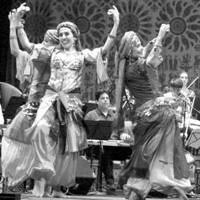
|
The Society of Folk Dance Historians (SFDH)
The "Hootchie Kootchie"
[
Home |
About |
Encyclopedia | CLICK AN IMAGE TO ENLARGE |

|
"I'll be your Tootsie Wootsie.
We'll dance the Hootchie Kootchie."
 This line from "Meet Me in St. Louis, Loui" prompted a challenge from several dancers at the 2004 West Coast Ragtime Festival in Sacramento, California. Surely, as a dance historian, I should know what the "Hootchie Kootchie" was. And could I teach it? I had a notion, but wisely held my tongue until I could verify my notion lest I place my foot where my tongue is.
This line from "Meet Me in St. Louis, Loui" prompted a challenge from several dancers at the 2004 West Coast Ragtime Festival in Sacramento, California. Surely, as a dance historian, I should know what the "Hootchie Kootchie" was. And could I teach it? I had a notion, but wisely held my tongue until I could verify my notion lest I place my foot where my tongue is.
So, I did verify it and here is the history of the "Hootchie Kootchie."
It all began at the 1893 Chicago World's Fair with shameless promoters attempting to separate the rubes from their hard-earned cash. At the time, Egypt and the Middle East were unknown and exotic places, subject to the whims and imaginations of young men everywhere. At the end of the Victorian Age, when the mere sight of a lady's ankle was enough to set a man's pulse racing, the image of scantily-clad exotic dancers was enticing and forbidden fruit indeed. Irene Castle's bold move in shortening her skirts during the Castles' decade of fame changed all that, but that's another story. Back to the Hootchie Kootchie.
One of the most interesting of the dances of the Middle East was the dance of the Ghawazi of Egypt, performed in the photo above by the UCSB Middle East Ensemble Dancers. This closely-knit group was and is essentially a tribe with a tradition among their young women as entertainers – as dancers and otherwise. Their costume consisted of a knee-length skirt with rows of fringe and a sequined bodice. Their dance was a wonder of shimmying hips and shoulders, accompanied by ringing zils (finger symbols), requiring intense training. The Ghawazi still work as entertainers to this day on Nile River cruise boats.
It was the dance of the Ghawazi that promoters thought they were bringing to Chicago, Illinois. Their dancer was billed as "Little Egypt," straight from the harems of the Orient. It must be remembered that in those days, the Middle East was considered to be the beginning of the Orient (thus, the name "Orient Express" of the train from England and France to İstanbul, Turkey). Little Egypt was going to reveal all the wicked pleasures of the Orient and the sex-deprived males of middle America couldn't wait to see her dance, billed as, what else, the "Hootchie Kootchie." Tacky, indeed, but titillating to the early 20th Century male.
They must have been terribly disappointed; though showing some ankle and bare feet, the dancer was swathed in loose-fitting, flowing garments not vaguely resembling the Ghawazi dress. We have no record of how Little Egypt performed the Hootchie Kootchie, but we are free to imagine it as being somewhat similar to Egyptian women's social dances, which are not for public performance.
So successful was the Hootchie Kootchie fraud that it continued afterwards for many years in the traveling shows of burlesque and vaudeville. Peep shows appeared at county fairs throughout the country hawking the famous and deliciously evil Hootchie Kootchie. When "Meet Me in St. Louis, Loui" was written in the early years of the Ragtime Era, the Hootchie Kootchie was well-known as a term for a somewhat daring, naughty dance of one's imagination.
DOCUMENTS
- Choreography: American Ragtime to Swing, an article.
- Egypt, a country.
- Middle East, a region.
- Oriental Dance, an article.
- Richard Duree, an article.
Used with permission of the author.
Printed in Folk Dance Scene, June/July 2005.
This page © 2018 by Ron Houston.
Please do not copy any part of this page without including this copyright notice.
Please do not copy small portions out of context.
Please do not copy large portions without permission from Ron Houston.